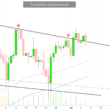Intel, a pioneer in microprocessors, is currently undergoing a significant business model transformation. The company aims to establish itself as a major contract chip manufacturer based in the United States, with support from the government. This strategic move comes at a time when the global personal computer industry has experienced eight consecutive quarters of declining unit sales. Additionally, Intel faces fierce competition from Advanced Micro Devices (AMD) in both the PC and server markets.
Despite these challenges, Intel has been striving to catch up with Nvidia and AMD in the graphics processor market, particularly for AI workloads. Unfortunately, the company’s revenue has declined by 21% during the first three quarters of the year, resulting in an operating loss of $2.5 billion.
Surprisingly, despite these setbacks, Intel’s stock has rallied impressively by 91%. Although this growth falls behind Nvidia’s surge of 240% and AMD’s rise of 132%, it remains the largest annual increase in Intel’s share price over the past two decades.
Intel’s Undervaluation and Potential Growth
There are compelling reasons to believe that Intel’s stock rally is far from over. Gus Richard, a chip analyst at Northland Securities, argues that the stock is significantly undervalued. Richard has recently set a price target of $68, which reflects an increase of more than 30% from the current level. This bold prediction makes him Wall Street’s most bullish analyst regarding Intel’s future.
Richard’s optimism stems from two key factors. Firstly, he believes that Intel’s overall outlook is improving across multiple fronts. Secondly, he suggests that investors should consider Intel’s potential by evaluating the sum of its parts, as he perceives the company to be in the process of breaking itself up.
The Road to Recovery: Reclaiming Technological Leadership
One of the main hurdles Intel has faced in recent years is a decline in its manufacturing prowess, despite it being a long-standing core strength. However, Richard predicts that Intel will regain its leadership position in process technology by 2025, potentially even sooner, surpassing Taiwan Semiconductor and other competitors.
Moreover, Richard expects Intel’s newfound focus on efficiency to drive the non-GAAP gross margin to nearly 53% by 2025, a significant improvement from the 43% recorded in 2023. He emphasizes that over the past two decades, the company with the best access to process technology has gained substantial market share. Intel’s announcement that it has already secured three customers for its cutting-edge 18-angstrom chip factory line in Arizona serves as evidence of its revitalized manufacturing strength.
In conclusion, despite its recent challenges and competitive landscape, Intel shows promising signs of future success. With its projected technological advancements and strategic focus on efficiency, Intel has the potential to unlock significant value for its shareholders.
Predicted Revenue Growth and Profit Projections
According to Richard, revenue growth is expected to recover to 8% next year and reach 16% by 2025. In terms of non-GAAP profits, he predicts earnings of 94 cents per share in 2023, $2 per share next year, and $3.30 per share in 2025.
Outlook on PC Demand and the Role of AI
While Richard cautions that PC demand will remain soft in the first half of 2024, he anticipates a recovery afterwards. He believes that the wave of PCs purchased during the pandemic will start to age out, leading to strengthening demand in 2025. Additionally, Richard is optimistic about the potential impact of AI on PC usage, particularly in areas such as content creation and productivity applications. He expects emerging technologies in 2024 to drive up PC sales in 2025.
Intel’s Strategic Moves
Richard observes that Intel is currently undergoing a process of splitting itself into five separate companies. The initial step began in 2022 with the IPO for Mobileye, an autonomous driving technology company, where Intel holds an 88% stake valued at approximately $30 billion.
In addition, Intel plans to hold an IPO for Altera, a field programmable gate array company it acquired in 2015. Recently, Intel also sold a combined 30% stake in IMS Nanofabrication, a masking tool manufacturer used in extreme ultraviolet lithography, to Taiwan Semi and Bain Capital.
Richard further predicts that Intel will eventually split its products and foundry businesses. He estimates that Intel’s foundry arm, if it were to be separated as a stand-alone business, would become the world’s second-largest player after TSMC with an estimated value of $100 billion.
Implications for Shareholders
While sum-of-the-parts analyses often fail to accurately reflect future events, Intel’s situation appears to be different. In June, Intel announced plans to treat its products and foundry segments as separate businesses. Although the company has stated that it has no immediate intentions of breaking them apart, Richard believes that the split is inevitable and that shareholders will benefit when it eventually takes place.






